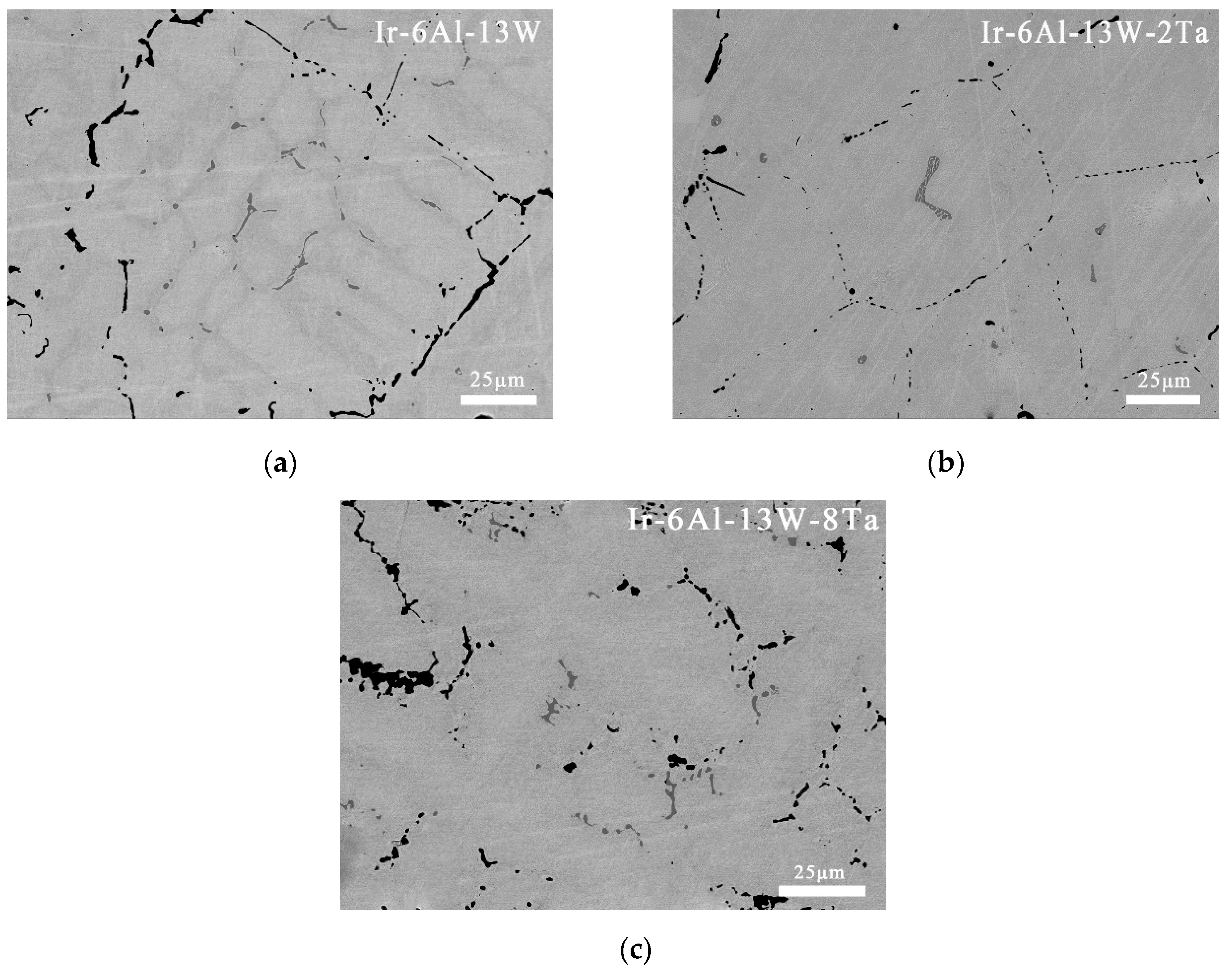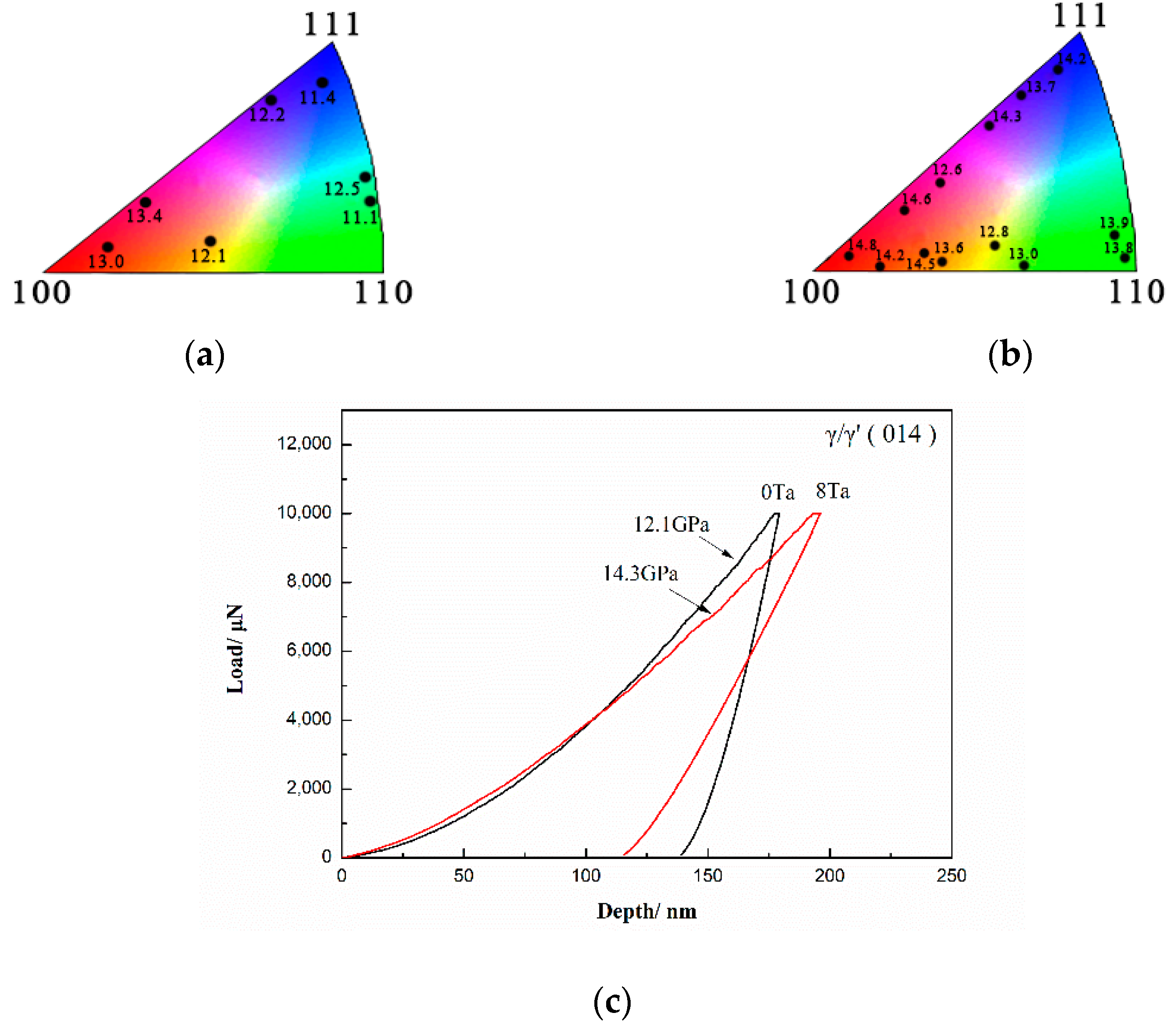Microstructure Evolution and Mechanical Properties of Novel γ/γ′ Two-Phase Strengthened Ir-Based Superalloys
Abstract
:1. Introduction
2. Materials and Methods
3. Results
3.1. Phase Relationship
3.2. Microstructural Morphologies
3.2.1. As-Cast Microstructures
3.2.2. Heat-Treated Microstructures
3.3. Compression at Room Temperature and 1300 °C
3.4. Orientation-dependent Nanoindentation Properties
4. Discussion
5. Conclusions
- (1)
- The addition of Ta contributes to the change of volume fraction, size, and lattice parameters of the γ′-Ir3(Al, W), and the angles of exhibiting peaks slightly decrease.
- (2)
- The γ/γ′ two-phase microstructure can be further enhanced by the addition of Ta, and these crystallographic orientations in matrix phase close to (111) have lower nanohardness compared with other regions, which could be caused by solute-induced softening.
- (3)
- Ta effectively improves the high-temperature mechanical properties of Ir-based superalloys, and the increased compressive strength of Ir–6Al–13W–xTa quaternary alloys can be attributed to the precipitation of γ′-Ir3(Al, W) phase and solid solution strengthening. The Ta-containing Ir–Al–W two-phase quaternary alloys show some potential in applications as a new class of refractory superalloy.
Author Contributions
Funding
Acknowledgments
Conflicts of Interest
References
- Yamabe-Mitarai, Y.; Gu, Y.; Huang, C.; Volkl, R.; Harada, H. Platinum-group-metal-based intermetallics as high-temperature structural materials. JOM 2004, 9, 34–39. [Google Scholar] [CrossRef]
- Tanaka, K.; Ooshima, M.; Tsuno, N.; Sato, A.; Inui, H. Creep deformation of single crystals of new Co-Al-W-based alloys with fcc/L1(2) two-phase microstructures. Philos. Mag. 2012, 32, 4011–4027. [Google Scholar] [CrossRef]
- Shinagawa, K.; Omori, T.; Oikawa, K.; Kainuma, R.; Ishida, K. Ductility enhancement by boron addition in Co-Al-W high-temperature alloys. Scripta Mater. 2009, 6, 612–615. [Google Scholar] [CrossRef]
- Miura, S.; Ohkubo, K.; Mohri, T. Mechanical properties of Co-based L12 intermetallic compound Co3 (Al, W). Mater. Trans. 2007, 9, 2403–2408. [Google Scholar] [CrossRef]
- Bauer, A.; Neumeier, S.; Pyczak, F.; Goken, M. Microstructure and creep strength of different gamma/gamma ‘-strengthened Co-base superalloy variants. Scripta Mater. 2010, 12, 1197–1200. [Google Scholar] [CrossRef]
- Makineni, S.K.; Samanta, A.; Rojhirunsakool, T.; Alam, T.; Nithin, B.; Singh, A.K.; Banerjee, R.; Chattopadhyay, K. A new class of high strength high temperature Cobalt based γ–γ′ Co-Mo-Al alloys stabilized with Ta addition. Acta Mater. 2015, 97, 29–40. [Google Scholar] [CrossRef]
- Hosoda, H.; Takahashi, T.; Takehara, M.; Kingetsu, T.; Masumoto, H. Phase stability and mechanical properties of IrAl alloys. Mater. Trans. Jim 1997, 10, 871–878. [Google Scholar] [CrossRef]
- Omori, T.; Makino, K.; Shinagawa, K.; Ohnuma, I.; Kainuma, R.; Ishida, K. Phase equilibria and mechanical properties of the Ir-W-Al system. Intermetallics 2014, 55, 154–161. [Google Scholar] [CrossRef]
- Yamabe, Y.; Koizumi, Y.; Murakami, H.; Ro, Y.; Maruko, T.; Harada, H. Development of Ir-base refractory superalloys. Scripta Mater. 1996, 2, 211–215. [Google Scholar] [CrossRef]
- Sato, J.; Omori, T.; Oikawa, K.; Ohnuma, I.; Kainuma, R.; Ishida, K. Cobalt-base high-temperature alloys. Science 2006, 5770, 90–91. [Google Scholar] [CrossRef]
- Ooshima, M.; Tanaka, K.; Okamoto, N.L.; Kishida, K.; Inui, H. Effects of quaternary alloying elements on the γ′ solvus temperature of Co-Al-W based alloys with fcc/L12 two-phase microstructures. J. Alloys Compd. 2010, 1, 71–78. [Google Scholar] [CrossRef]
- Suzuki, A.; Pollock, T.M. High-temperature strength and deformation of γ–γ′ two-phase Co-Al-W-base alloys. Acta Mater. 2008, 6, 1288–1297. [Google Scholar] [CrossRef]
- Suzuki, A.; DeNolf, G.C.; Pollock, T.M. Flow stress anomalies in γ–γ′ two-phase Co-Al-W-base alloys. Scripta Mater. 2007, 5, 385–388. [Google Scholar] [CrossRef]
- Kobayashi, S.; Tsukamoto, Y.; Takasugi, T. The effects of alloying elements (Ta, Hf) on the thermodynamic stability of γ′-Co3(Al, W) phase. Intermetallics 2012, 31, 94–98. [Google Scholar] [CrossRef]
- Chiba, A.; Ono, T.; Li, X.G.; Takahashi, S. High-temperature strength of Ni-doped IrAl with the B2 type ordered crystal structure. Intermetallics 1998, 1, 35–42. [Google Scholar] [CrossRef]
- Jiang, C.; Du, Y. Thermodynamic and mechanical stabilities of γ′-Ir-3(Al, W). J. Appl. Phys. 2011, 2, 10. [Google Scholar]
- Cawkwell, M.J.; Nguyen-Manh, D.; Woodward, C.; Pettifor, D.G.; Vitek, V. Origin of brittle cleavage in iridium. Science 2005, 5737, 1059–1062. [Google Scholar] [CrossRef]
- Vernier, S.; Franchet, J.M.; Lesne, M.; Douillard, T.; Silvent, J.; Langlois, C.; Bozzolo, N. iCHORD-SI combination as an alternative to EDS-EBSD coupling for the characterization of γ–γ′ nickel-based superalloy microstructures. Mater. Charact. 2018, 142, 492–503. [Google Scholar] [CrossRef]
- Tao, Y.; Yi, L.; Zeli, L. Nanoindentation Size Effect of Iridium Single Crystal. Precious Metals 2016, 37, 27–32. [Google Scholar]
- Rahimian Koloor, S.; Karimzadeh, A.; Tamin, M.; Abd Shukor, M. Effects of Sample and Indenter Configurations of Nanoindentation Experiment on the Mechanical Behavior and Properties of Ductile Materials. Metals 2018, 8, 421. [Google Scholar] [CrossRef]
- Gu, Y.F.; Yamabe-Mitarai, Y.; Ro, Y.; Harada, H. Microstructure and deformation behavior of Ir-Nb two-phase refractory superalloys for various Nb content. Scripta Mater. 1999, 11, 1313–1319. [Google Scholar] [CrossRef]
- Ding, Z.; Song, Y.; Ma, Y.; Huang, X.; Zhang, T. Nanoindentation Investigation on the Size-Dependent Creep Behavior in a Zr-Cu-Ag-Al Bulk Metallic Glass. Metals 2019, 9, 613. [Google Scholar] [CrossRef]
- Trinkle, D.R.; Woodward, C. The chemistry of deformation: How solutes soften pure metals. Science 2005, 310, 1665–1667. [Google Scholar] [CrossRef] [PubMed]








© 2019 by the authors. Licensee MDPI, Basel, Switzerland. This article is an open access article distributed under the terms and conditions of the Creative Commons Attribution (CC BY) license (http://creativecommons.org/licenses/by/4.0/).
Share and Cite
Fang, X.; Hu, R.; Yang, J.; Liu, Y.; Wen, M. Microstructure Evolution and Mechanical Properties of Novel γ/γ′ Two-Phase Strengthened Ir-Based Superalloys. Metals 2019, 9, 1171. https://doi.org/10.3390/met9111171
Fang X, Hu R, Yang J, Liu Y, Wen M. Microstructure Evolution and Mechanical Properties of Novel γ/γ′ Two-Phase Strengthened Ir-Based Superalloys. Metals. 2019; 9(11):1171. https://doi.org/10.3390/met9111171
Chicago/Turabian StyleFang, Xiao, Rui Hu, Jieren Yang, Yi Liu, and Ming Wen. 2019. "Microstructure Evolution and Mechanical Properties of Novel γ/γ′ Two-Phase Strengthened Ir-Based Superalloys" Metals 9, no. 11: 1171. https://doi.org/10.3390/met9111171





